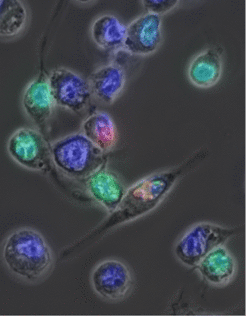Cellular toxicity of protein aggregation

Cytotoxicity of polyQ expansions proteins
Schaffar et al, 2004, Mol. Cell 15, 95-105
Although the clinical symptoms of neurodegenerative diseases vary, many of them have one observable feature in common: the accumulation of protein clumps (aggregates) inside or outside of nerve cells. It remains unclear, however, how these protein aggregates cause cellular toxicity and neurodegeneration. We are using biochemical and cell biological approaches to gain insight into the molecular basis of neurodegenerative disorders associated with aberrant protein folding, such as Alzheimer’s, Parkinson’s and Huntington’s disease. Our long-term goal is to understand the mechanisms by which protein misfolding and aggregation cause cellular toxicity and how molecular chaperones and cellular stress response pathways are involved in this process. This question is of general importance in understanding neurodegenerative misfolding diseases, which we address with cellular model systems, including budding yeast and cultured mammalian cells. In addition, we use the nematode worm Caenorhabditis elegans as a model organism to study the relationship between aberrant folding and aging. We hope that our work will help in developing new strategies in the therapy of neurodegenerative disorders caused by protein aggregation.
Publications
Selected reviews
Hipp, M.S.; Park, S.-H.; Hartl, F.U. (2014). Proteostasis impairment in protein-misfolding and -aggregation diseases. Trends in Cell Biol. 24, 506-514.
Hipp, M. S.; Kasturi, P., and Hartl, F. U. (2019). The proteostasis network and its decline in ageing. Nature Rev. Mol. Cell Biol. 20, 421-435.
